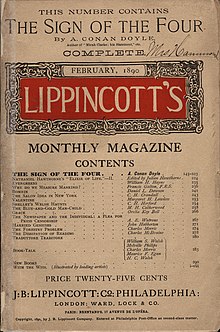The Sign of the Four

One of the coversheets to the original serial publication of the novel in Lippincott’s Monthly Magazine
|
|
| Author | Arthur Conan Doyle |
|---|---|
| Country | United Kingdom |
| Language | English |
| Series | Sherlock Holmes |
| Genre | Mystery novel |
| Publisher |
Lippincott's Monthly Magazine Spencer Blackett (book) |
|
Publication date
|
February 1890 |
| Media type | Print (Magazine, Hardback & Paperback) |
| Preceded by | A Study in Scarlet |
| Followed by | The Adventures of Sherlock Holmes |
How often have I said to you that when you have eliminated the impossible, whatever remains, however improbable, must be the truth?
The Sign of the Four (1890), also called The Sign of Four, is the second novel featuring Sherlock Holmes written by Sir Arthur Conan Doyle. Doyle wrote four novels and 56 stories starring the fictional detective.
The story is set in 1888.The Sign of the Four has a complex plot involving service in India, the Indian Rebellion of 1857, a stolen treasure, and a secret pact among four convicts ("the Four" of the title) and two corrupt prison guards. It presents the detective's drug habit and humanizes him in a way that had not been done in the preceding novel, A Study in Scarlet (1887). It also introduces Doctor Watson's future wife, Mary Morstan.
According to Mary, in December 1878, her father had telegraphed her upon his safe return from India and requested her to meet him at the Langham Hotel in London. When Mary arrived at the hotel, she was told her father had gone out the previous night and not returned. Despite all efforts, no trace has ever been found of him. Mary contacted her father's only friend who was in the same regiment and had since retired to England, one Major John Sholto, but he denied knowing her father had returned. The second puzzle is that she has received six pearls in the mail from an anonymous benefactor, one per year since 1882 after answering an anonymous newspaper query inquiring for her. With the last pearl she received a letter remarking that she has been wronged and asking for a meeting. Holmes takes the case and soon discovers that Major Sholto had died in 1882 and that within a short span of time Mary began to receive the pearls, implying a connection. The only clue Mary can give Holmes is a map of a fortress found in her father's desk with the names of Jonathan Small, Mahomet Singh, Abdullah Khan and Dost Akbar.
Holmes, Watson, and Mary meet Thaddeus Sholto, the son of the late Major Sholto and the anonymous sender of the pearls. Thaddeus confirms the Major had seen Mary's father the night he died; they had arranged a meeting to divide a priceless treasure Sholto had brought home from India. While quarreling over the treasure, Captain Morstan—long in weak health—suffered a heart attack. Not wanting to bring attention to the object of the quarrel—and also worried that circumstances would suggest that he had killed Morstan in an argument, particularly since Morstan's head struck a table as he fell—Sholto disposed of the body and hid the treasure. However, he himself suffered from poor health and an enlarged spleen (possibly due to malaria, as a quinine bottle stands by his bed). His own health became worse when he received a letter from India in early 1882. Dying, he called his two sons and confessed to Morstan's death and was about to divulge the location of the treasure when he suddenly cried, "Keep him out!" before falling back and dying. The puzzled sons glimpsed a face in the window, but the only trace was a single footstep in the dirt. On their father's body is a note reading "The Sign of Four". Both brothers quarreled over whether a legacy should be left to Mary Morstan, and Thaddeus left his brother Bartholomew, taking a chaplet and sending its pearls to Mary. The reason he sent the letter is that Bartholomew has found the treasure and possibly Thaddeus and Mary might confront him for a division of it.
...
Wikipedia
